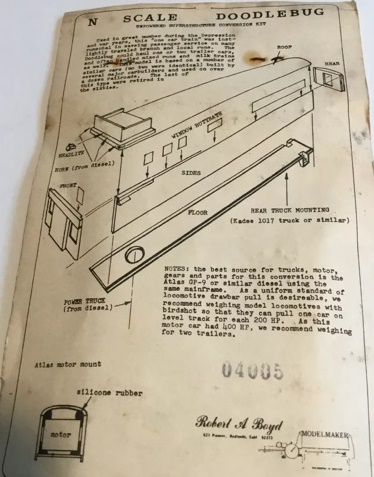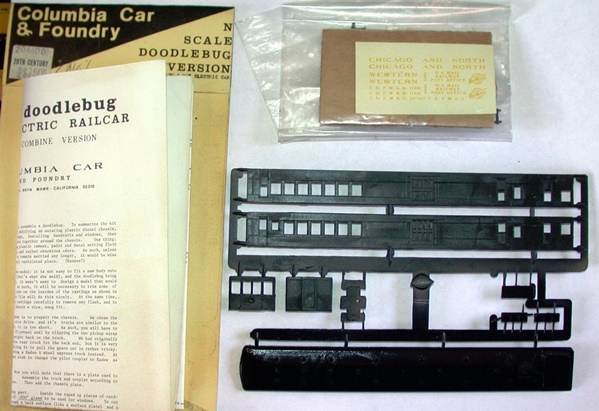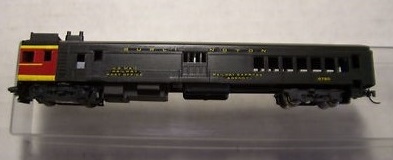

Introduced: 1998 (DC version) and 2011 (DCC version)
Whether you're talking looks, performance, or sheer novelty factor, the original 1998 version of Bachmann's Doodlebug was probably the best of the early (pre-2000) Bachmann "Spectrum" locomotives. Unfortunately, I had to buy (and return) several of them before I finally got one that ran worth a darn (which about sums up 1990's Bachmann quality control for ya).

The frame is all metal (albeit fairly minimalistic). Most of the actual weight is concentrated in the forward (non-passenger) section of the chassis. The motor is an open-sided / skew-wound 5-poler. A single flywheel is attached to the forward driveshaft (the rear driveshaft is connected to bloody nothing). Only the forward truck is powered, although both trucks provide pickup. A two-piece plastic driveshaft runs from the flywheel to the powered truck (one of those telescoping / swiveling deals). All gearing is plastic. Wheelback wipers collect current from six of the eight wheels (two of the wheels on the forward truck being equipped with traction tires). More wipers transfer current from the trucks to the chassis. A PC board atop the forward section of the chassis provides directional control for the headlight as well as constant lighting for the coach interior. The pilot coupler is a dummy knuckle fixed to the shell. The rear coupler (a Rapido) is kind of interesting. It's mounted to some sort of gee-whiz rotating assembly on the chassis, and actually pivots in concert with the rear truck. And no, these models do not come with passengers (I added those myself).
Despite the minimalistic pickup / propulsion scheme, performance is surprisingly good. Throttle response is smooth, pickup is fine through turnouts (probably because the trucks are so far apart), and slow speed creep is excellent. Unfortunately, these things make a lot of noise (probably due, at least in part, to the aforementioned pivoting driveshaft). All of that open space inside the shell doesn't seem to help much either, as mine runs considerably quieter with the shell removed.
The gears in this first version are comprised of the same white plastic that caused so many problems with Bachmann's other locomotives of the 1990s (shrinking, cracking, warping, etc). However, having said that, I've never actually had any problems with the gears in mine, so maybe I just got lucky.
Bachmann discontinued this model after its first (1998) production run - at least for a while. However, they did finally re-release it in 2011 with a new decoder-equipped mechanism (not to mention an accompanying heavyweight coach "trailer") -

The motor was changed to a closed-sided can (presumably the same 3-poler used in Bachmann's other locomotives of similar vintage). The PC board now incorporates a DCC decoder and runs the entire length of the chassis. LEDs on the board provide illumination for the headlight as well as the interior (unfortunately, the decoder does not provide a function for controlling the interior lighting). The pivoting rear coupler gizmo has been replaced with a chassis-mounted E-Z Mate (Bachmann's McHenry-esque automatic/magnetic coupler). The white plastic gears have been changed to more reliable black plastic. The free-floating weight that used to mount to the front of the chassis is gone (presumably to accommodate the new decoder board). The trucks, chassis, shell, shell detailing, and pretty much everything else are the same as on the first version.
Overall performance on this new version is every bit as good as the first one - smooth throttle response, great slow speed creep, reasonable top-end speed, no pickup or tracking problems, etc. Unfortunately, although infinitely quieter than the original version, these still make more noise than we'd like to see nowadays. And since the slight "coffee grinder" style racket seems to manifest itself mainly through curves, my Finger O' Blame remains pointed at that pivoting driveshaft.
In addition to the minor noise issues, I've also read various reports of new Doodlebugs that tend to slow down rather drastically through curves and run a bit herky-jerky overall. Apparently this is due to the way the two halves of of the powered truck were put together at the factory. Popping the truck out of the chassis and playing around with the screws (either loosening them, tightening them, or some combination of both) reportedly solves these problems. It also cuts down on the noise a bit (or at least it did on mine). Lubricating the worm and truck gears can also help cut down on the buzzing, although I still haven't figured out a way to eliminate it entirely.

So, this new version is definitely an upgrade over the original. However, given the slight noise issues and the relatively primitive pickup scheme (vis'a'vis all those wipers), I can't quite give it an "A" rating.
Here's what Bachmann has to say about the new version -
Becoming popular during the Great Depression, this self-propelled passenger car with an extra baggage section was nicknamed the "Doodlebug." Bachmann is delighted to offer a DCC-equipped Doodlebug in N scale that features a NMRA-compliant decoder, LED lighting, and extensive fine scale detailing.
Features -
- DCC-equipped for speed, direction, and lighting
- Dual-mode NMRA-compliant decoder
- Precision can motor with flywheel drive
- Die-cast gear box
- One-piece die-cast chassis
- Die-cast gear tower with bronze bearings
- Directional headlight
- Constant interior lighting
- Brill trucks
- Blackened metal NMRA wheel profile
- Operating E-Z Mate Mark II magnetic couplers
Trailer coach features -
- 72' coach with finescale details and interior
- LED constant lighting (analog and DCC operation)
- Die-cast four-wheel Pullman trucks with all-wheel electrical pickup
To remove the shell, use four toothpicks (or whatever) to separate the shell/window assembly from the chassis (just inward from each truck). Slots in the window inserts hold the shell to the tabs on the chassis, so it should pop off readily at that point.
Grade: B (either version)
Trivia - Back circa 1980, Robert Boyd created a couple of slightly different Doodlebug shell kits (one branded as "Robert Boyd" and the other branded as "Columbia Car & Foundry"). These were designed to run using either an Atlas/Roco FA-1 or an Atlas/Roco GP9 power chassis. The models are based on different prototypes than Bachmann's (looks to be C&NW). However, they are beyond rare, so good luck finding one.



First version reviewed: 12/98 Railroad Model Craftsman, 8/98 Model Railroader ("The newest addition to Bachmann's N scale Spectrum line is a nicely detailed and smooth-running model of a typical gas-electric car, more commonly known as a "doodlebug"... Bachmann's model is an N scale version of its HO gas-electric car introduced last year. Like its larger counterpart, the N scale model is not a model of a specific prototype, but with its boxy construction and flat nose resembles many of the more than 400 motor cars built in the 1920s and '30s by Electro-Motive Corp.
"Bachmann's model has a die-cast chassis with an injection-molded styrene shell. The five-pole skew-wound motor powers the front-truck only. The rear half of the model includes an injection-molded coach seat interior and a light bulb for the interior lighting. The front headlight is a yellow LED wired to the front circuit board. Lighting is directional and not constant. The model measures 10'-0" wide, 71'-0" long and 12'-0" tall to the top of the roof. These measurements are typical of prototype doodlebugs, which were usually between 65 and 75 feet long. The body molding is nicely done, but I found the rivets to be a bit too heavy, especially along the belt rail. The molded-on grabs are nicely proportioned. The assortment of underbody and roof details are nice additions to the model and reflect typical prototype practice...
"The model ran well, although there was quite a bit of gear noise. I followed Bachmann's lubricating instructions, which reduced the gear noise. Although only the front truck is powered, both trucks pick up electricity... The doodlebug has enough power to pull more than 20 cars, far more than its prototype. All the wheels on our sample were in gauge, and the coupler was the correct height... The rear coupler features a lever that makes it pivot with the rear truck... Modelers of the 1920s through the '60s can't go wrong with this model for branchline passenger service. Undec, UP, B&O, PRR, AT&SF, GN. Price: $49.95")